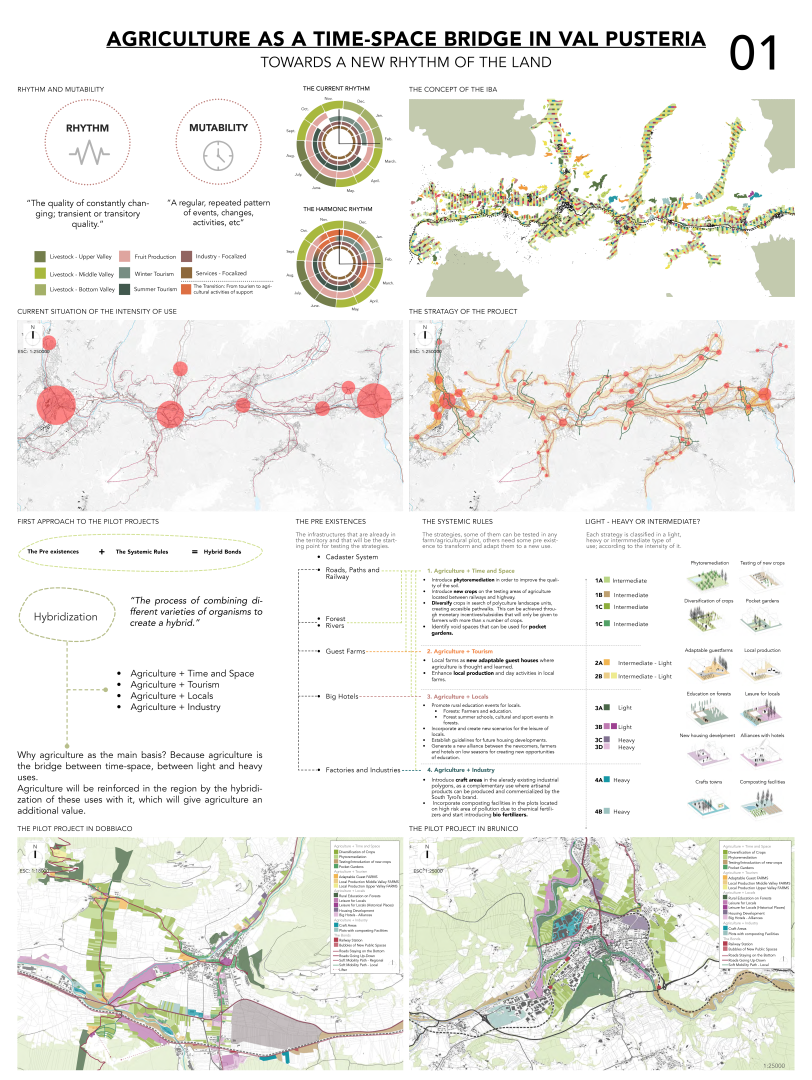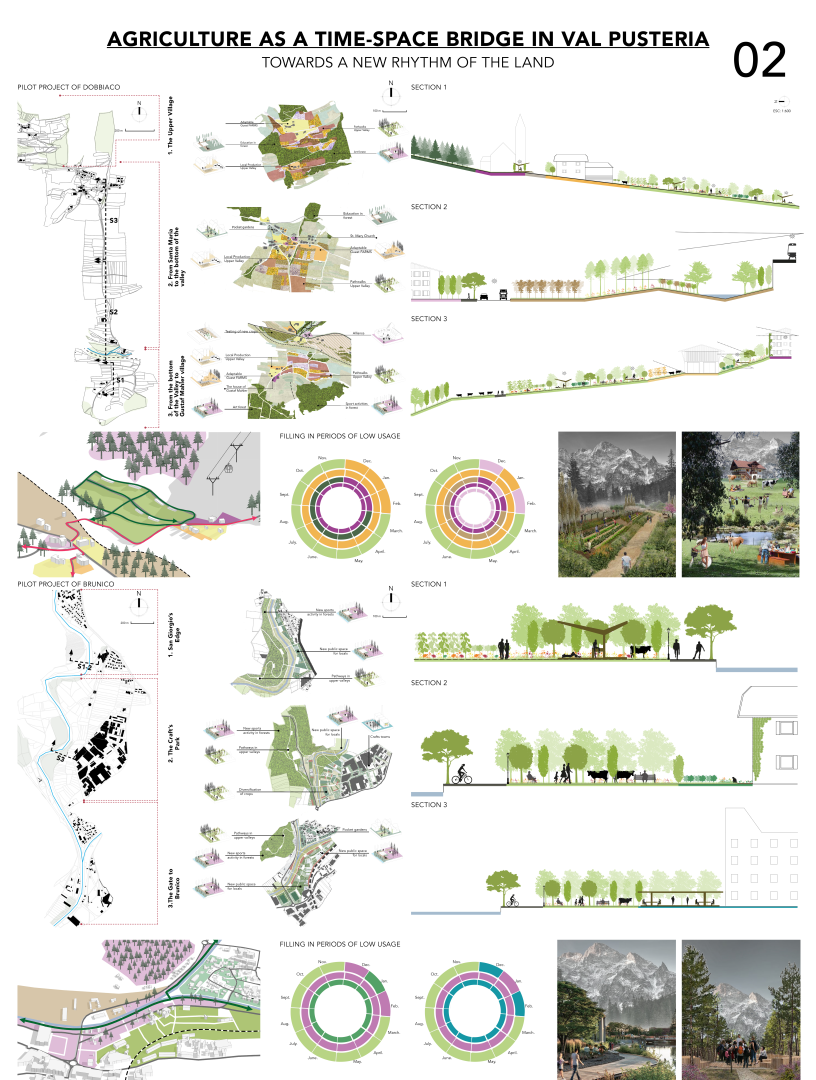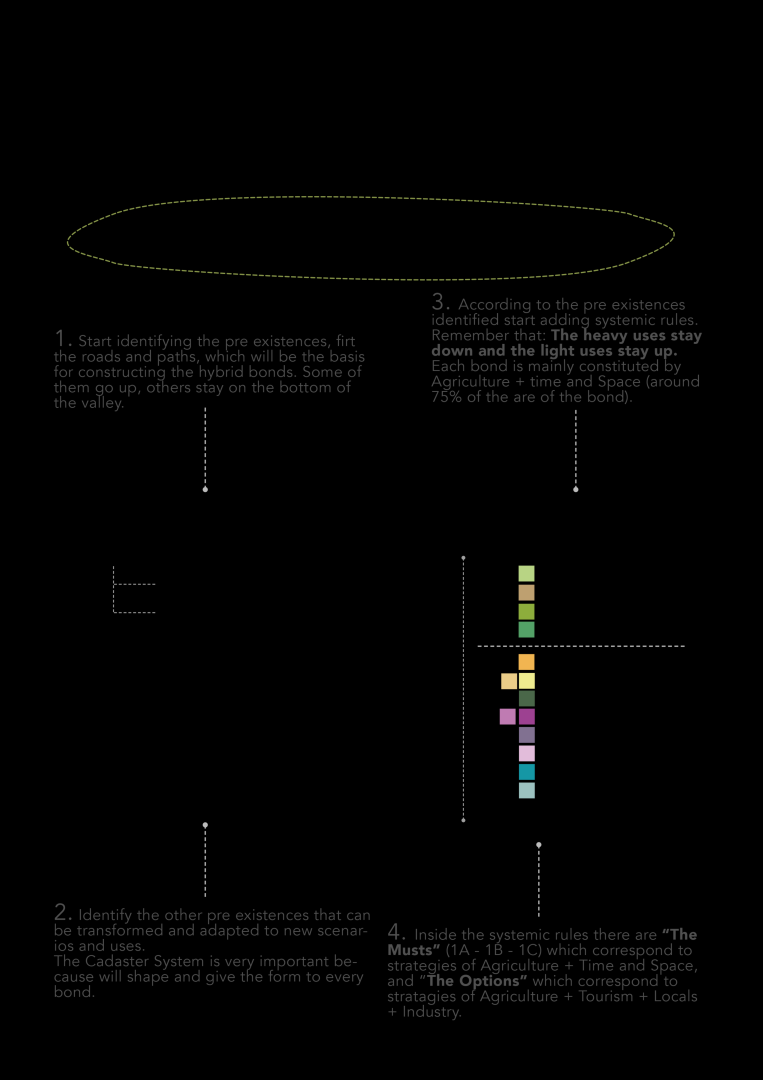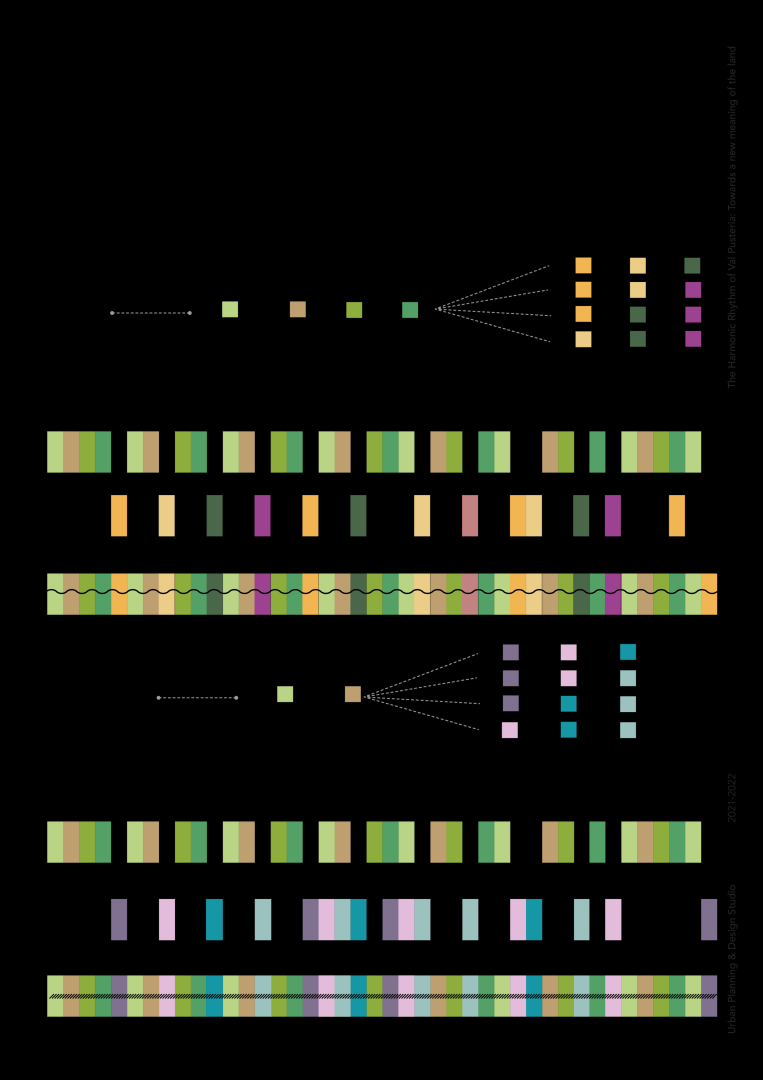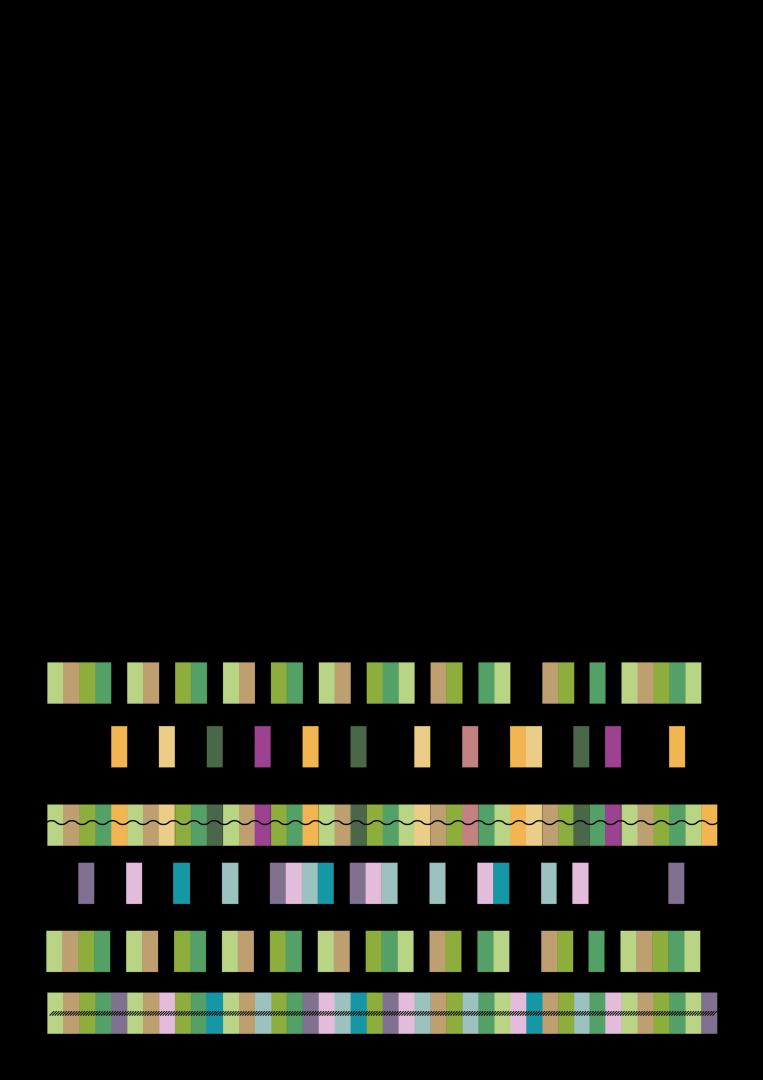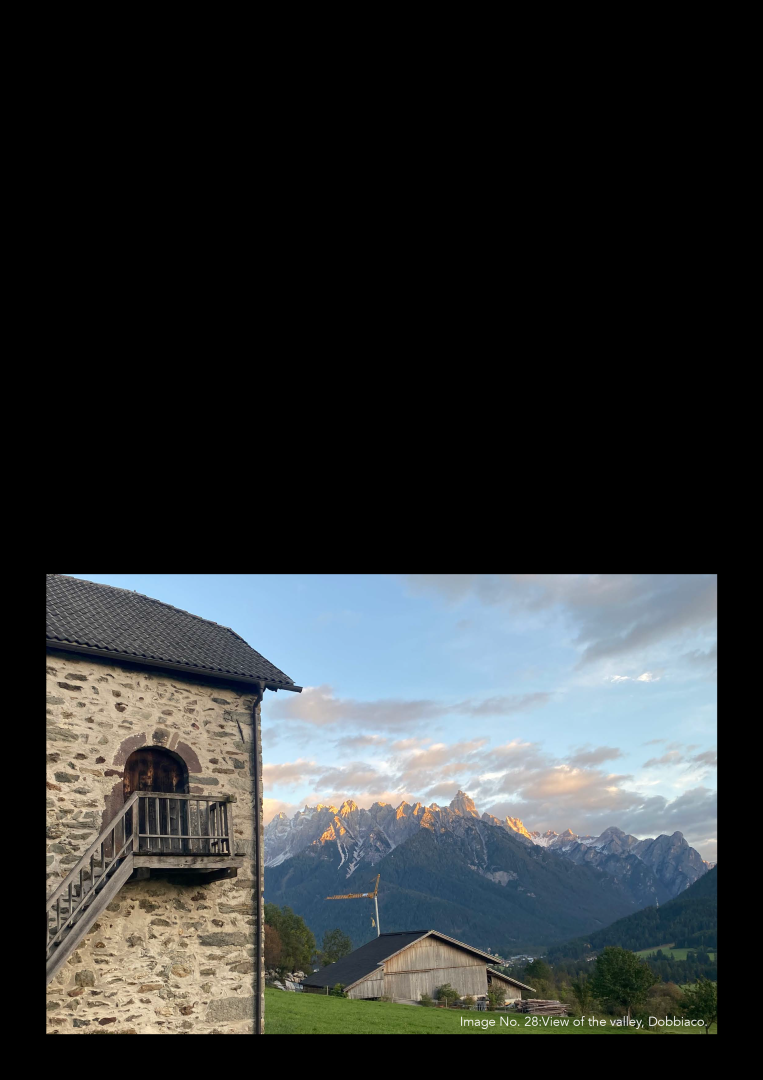Agriculture as the Time-Space Bridge
Basic information
Project Title
Full project title
Category
Project Description
Val Pusteria is strongly determined and shaped by the mountains and rivers that cross its territory, they had left small usable areas for human beings, who by nature, have managed to take advantage over time, being this transformed from local consumption to a global market. But, how much more can this territory support this macro transformation? This work aims to approach these issues through agriculture, as the bridge and starting point of the relationship between humans and the territory.
Geographical Scope
Project Region
Urban or rural issues
Physical or other transformations
EU Programme or fund
Which funds
Description of the project
Summary
Our project aims to solve from agriculture, a series of challenges present in Val Pusteria
In this work it is proposed to imagine the territory from agriculture as the starting point, as the bridge to change the current rhythm of Val Pusteria so, how can the territory be shaped through agriculture?
We started from the analysis of the site, identifying its characteristics that made us understand the way in which the valley works, concluding that one of the main activities that shaped the space was agriculture. The way in which the uses and their intensity were located throughout the territory was identified. We noted several dualities as predominant characteristics, and based on this we formulate the following hypothesis: Can agriculture be the link between all uses?
For this, a diagnosis was made on the type of agricultural activity that was carried out on the site. Considering the previous aspects, some basic concepts were proposed, which were: rhythm and mutability. Taking the above into account, we arrive at the concept of the Time-Space bridge: The valley has different times throughout the year. In each season different activities are developed that are also changing in space. In this way, we arrive at the framework, where two key concepts are proposed: Landscape units and Hybridization. The landscape units are made up of hybrids in the categories of Agriculture + Tourism, Time-space, Industry, and Locals. In this way, agriculture is consolidated as the support system for the rest of the activities.
Key objectives for sustainability
The diverse strategies proposed, aim to promote frameworks which can respond to the diverse phenomena that environmental sustainability faces. It should be noted that the strategies presented were based on the principles of the sustainable development goals, for which they focus primarily on solving the following sustainability challenges: Industry, innovation and infrastructure: Through the definition of spaces for the development of craft towns as a possible alternative to conventional industry. Circular economy framework. Responsible consumption and production, life cycle assessment (s) Waste management: Through the definition of spaces for the development of composting facilities, craft towns and crops diversification. Food security and resilient / sustainable agriculture: Through the definition of spaces for diversification of crops, the creation of pocket gardens and the definition of areas for composting facilities with the final goal of producing bio fertilizers. Quality education and education facilities infrastructure: Through the promotion of rural education and the creation of spaces for summer schools in the forest as well as spaces for the development of sports and cultural activities. Biodiversity protection: Through the definition of spaces for the diversification of crops. Climate action:The definition of spaces for the design of composting facilities will contribute to the production of biofertilizers, which will reduce the greenhouse gas emissions generated in an indirect way through the production of synthetic fertilizers. On the other hand, the proposed actions regarding sustainable tourism will also contribute to this goal. Local farms as new adaptable guest houses where agriculture is thought and learned. Decent work, economic growth and employment creation: The design of craft towns, schools in the forest, the creation of sports and cultural spaces as well as sustainable tourism strategies will promote the generation of new employment.
Key objectives for aesthetics and quality
The two initial concepts on which our project was based were landscape units and hybridization. Landscape units are defined as “a part of the territory that shares similar physical and geographic characteristics. Their delineation can contribute to identifying the physical and social dynamics that emerge in the spatial environment and to propose strategies of planning and management of the territory.” Which is why throughout the conception of the project we always returned to the question of which is the land we are imagining here? Therefore, we concluded that the best way to develop the project was to try to link all these realities (physical, social, ecological, and economical) so that the landscape could be sustainable over time. The project has a general strategy on agriculture in time and space; Reinforce traditional agriculture as the main bridge between light and heavy uses and as a provider of other alternatives for a more sustainable economy and more diversified agriculture. And this strategy contemplates three different actions which aim to construct an aesthetic landscape while producing economic benefits and while generating new social links in the valley. The actions are the following ones: 1. Introduce phytoremediation to improve the quality of the soil. 2. Introduce new crops on the testing areas of agriculture located between railways and highways. 3. Diversify crops in search of polyculture landscape units, creating accessible path walks. This can be achieved through monetary incentives/subsidies that will only be given to farmers with more than x number of crops. 4. Identify void spaces that can be used for pocket gardens. All these actions will influence and shape directly the landscape but also will generate other social and economic benefits for the population. It is intended to add value to agriculture by diversifying and adding new uses, including new areas for public space that are submerged in crops.
Key objectives for inclusion
The main objectives in terms of inclusion are to ensure that the inhabitants of the region appropriate their territory through an activity that has been forgotten over the years and that today is not seen as important as it should be. Generating social bonds through agriculture is the fundamental basis of the project since from the relationship that is generated between the human being and the territory through this activity, different areas can be transformed and attacked and, in this way, include different types of populations. The following three strategies addressed by the project correspond to: 1.Agriculture+Tourism: Reinforce heritage, generate new alternatives for economic profit and spread tourism in time and space trough agriculture. 2. Agriculture+Locals: Enhance bonds between locals and nature, as providing new opportunities of interaction. 3.Agriculture+Industry: Incentivize small scale industry that can be globalized by the South Tyrol brand.
So, the main aim of the project is transforming these activities through agriculture and try to reach the needs of the population that live in the valley. These main actions correspond to the ones that will add an additional value to the agricultural fields while constructing the hybrid bonds. The hybrid bonds will be constructed with different aspects and elements visualized on the valley that nowadays present an intense rhythm, and that can be used as an opportunity to add value to the agricultural field. Agriculture+tourism will take massive and intensive tourism as an opportunity to generate new scenarios that will be sustainable over time. Agriculture+locals will tackle the people who live in the valley and how can new interactions be created between them and the territory. Agriculture+industry aims to slow down the intensive industrialization of the valley and generate new alternatives for a smaller scale type of industry
Physical or other transformations
Innovative character
In our project, the three dimensions mentioned above are inseparable parts of each other.
At the begging of the development of our project, we have set ourselves several challenges, where the idea of preservation of the environment and creation of new more sustainable types of activities were some of the most important ones. This can be explained by the fact that on the one hand, the observed territory is endowed with precious natural resources, but on the other hand, the land is overused by agricultural and tourism sectors. Our idea is that the great potentiality of nature can be realized with much less damage, supported by the development of different domains such as small-scale industries, education, long-term and sustainable tourism.
Moreover, our main concepts in terms of aesthetics and quality of experience are that our ideas of landscape units and hybridization are impossible without the support and involvement of the different social groups and stakeholders. One distinctive feature of the territory is that there is almost no vacant land to introduce innovations. Thus, the optimal solution is to work with the private territory mainly of farmer’s families through educational programs and monetary allocations. In addition, the idea of a hybrid zone uses collaboration, experience, and active involvement in the further implementation of the project of different stakeholders as a basis. The significant issue that can be attracted by this concept is a monoculture of agriculture, economy, and lifestyle noticeable in the area.

